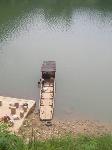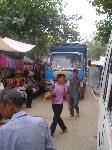- Getting around Lijiang. Dont stay in the Old Towns more than 2 days, there is nothing to do. KRISS Oct 9, 2013 05:46
- 2013 Beijing Temple Fair BENNYLAU Feb 26, 2013 03:29
- Malaysian traveling from KUL - LAX vis Shanghai PVG ZATI_DY Jan 3, 2013 20:15
In Search of Dong Towers
- Views: 3324
- |Vote: 0 0
- |Add to Favorites
- |Recommend to Friends
Guizhou is one of the wettest regions of China and this heavy rainfall more often than not takes its toll on the roads, many of which are not even paved. One look at a map of Guizhou reveals a lack of major transport infrastructure throughout the southern regions which is also one of the poorest and most underdeveloped areas of China. What roads do exist follow the river valleys and are cut into the steep sometimes heavily wooded hillsides. The mountainous topography and numerous rivers contribute to the difficulty of road and rail construction but on the positive side this makes for one of the more interesting areas for the curious traveller to explore.
Living in one of China’s biggest cities I’m always looking to escape to more remote and quiet places. This need to get away sometimes means undertaking some lengthy journeys but I am not one for sitting on a bus for long trips. One way I minimise this is to stop frequently and change buses more often. While this might take longer and sometimes leaves me stranded in an unplanned destination it is often far more interesting.
We were on the road again looking for the famous Dong Drum Towers. With most of southern Guizhou being ‘off the beaten track’ it was no surprise that we needed to back tracked from Leishan in the early morning to Kaili and change buses for Rongjiang taking the upgraded road via Sandu. As we headed south from Kaili to Sandu the country was rolling hills and open valleys with a mixture of croplands, and roads winding up and down and around the hills, streams and villages. Like a roller coaster ride, this tends to upset many passengers and it is not uncommon to have one or more of them throwing up into a bag or out the windows.
Sandu, home of the largest Shui ethnic community and host of many significant festivals is the only town of any size in the region. We pulled over for a short lunch break at a small diner where most of the passengers including us grabbed a quick but delicious bite to eat. From Sandu we began to follow the beautiful Duliu River. The further south and east we travelled the steeper the mountains grew and the deeper the valley became. The river flowed slowly below – an opaque green – its banks and shoals studded with white sun bleached granite boulders.
Small villages nestled in the shade of grand old banyan trees along the bank at almost every turn. Buffalo tethered by their nose ropes wallowed in the shallows like large grey boulders. Young children swam and splashed in the warm afternoon sun. Women washed clothes, laying them flat to dry on the pebbly banks below the village while soft yellow feathered ducks paddled by feeding at the waters edge. Fishermen, in long narrow skiffs with a curved bamboo cover at one end, caste their nets wide across the water. At larger villages - especially those without a bridge - ferries transport goods, livestock and locals from one side to the other. Although no longer the only means of transportation, these rivers are still very much the lifeblood of this mountainous region.
Rongjiang and the surrounding villages was our day’s destination but on arrival in the early afternoon we made a unanimous decision to take the very next bus out of town. All the main streets as we drove in were ripped up and the whole city seemed shrouded in a thick layer of dust. The bus station was the worst – hot, dark and dingy – we had ever encountered and the next bus was leaving almost immediately. We quickly bought tickets and went outside to find it. One look at this bus and we began to regret not taking a direct connection from Kaili to Congjiang but we would have missed this wonderful experience. It seemed there was not one piece of the original bus remaining. The floor had patches on patches, the interior had been relined and second hand seats installed. Water dripped outside from the extra radiator water tank on the roof - a standard extra for most mountain buses.
We would leave when the freight had been loaded on board. It is common practice in remote and rural areas for there to be almost as much freight on a bus as there are passengers – sometimes the whole back seat is removed for this purpose. Several sacks were loaded, followed by a sheet of styrofoam which was laid on the floor by the door. Next came five slabs of frozen meat, covered by another sheet of styrofoam.
The bus was by no means full when we took our leave of Rongjiang which is situated on a sweeping bend at the junction of two rivers. We made our way south out of town crossing the second river before being forced to stop and wait while several buffalo were moved off the road where attempt was being made to load them into a truck. The road continued to follow the river although the banks here were even steeper with villages along the river relying more on fishing than farming. Salted fish drying shacks stood amongst the homes in almost every village.
Although this section of the road was undergoing a major reconstruction its condition did not improve. Around almost every bend there was either a landslide onto the road or a land slip that had taken the road out and down the slope towards the river. These rural bus drivers have to be admired as they safely negotiate obstacles - although not without a few heart stopping moments - on this slalom course of rally like conditions everyday. While travelling is slow and sometimes scary it is the more memorable for it.
These road works continued all the way into Congjiang which straddles the Duliu River high above its banks. We had no trouble finding accommodation. Like most small towns our host found us and as it was too late to travel further that day we followed the young lass home to a new guesthouse opposite the bus station. Y80 for a nice clean room was good value but the air-conditioner came for a price. Our room rate included toothbrush, soap and toilet paper but no towels. At our insistence very thin new hand towels materialized shortly after. Not able to get any information about buses to Zhaoxing we thought it best to be up early the next morning but we still managed to miss the first bus.
While we stood around the back of the station overlooking the river waiting for the second bus a group of young lads found us. One spoke good English and made a habit of hanging out at the bus station in the hope of meeting foreigners with whom he might practice. He saw English as his ticket out of his small village, Congjiang and perhaps even Guizhou. When our bus was ready to leave he was able to translate the driver’s generous offer to take us all the way to Zhaoxing, a further six or seven kilometres beyond Laoxiang, for a price of course. The alternative is to walk or take the tractor with the locals or as we discovered later there is a bus which leaves from the only crossroads in town.
Once again we were unprepared for the condition of the roads as we had thought nothing could be rougher than yesterdays. Again we followed the picturesque Duliu River valley, this time with fewer villages but we did glimpse the occasional village drum tower through the now lush natural vegetation. Overnight rain had left the roads a little wet. We eventually turned north away from the river up the muddiest and most deeply rutted road ever. This gradually gave way to a sealed surface which was only short lived. Again a complete stretch of road was being upgraded and the next 50 kilometres would be the worst we had ever travelled.
Concrete boxed edging was already in place and the rock road base was now being laid. Huge piles of jagged rocks were dumped at interval alternating from one side of the road to the other. Workers, mostly women were laying, by hand, these large rocks, which would then be overlaid with a layer of smaller rocks before being filled and finally covered in 20 to 30cms of concrete. What a back breaking job and a bum bruising ride. The countryside opened out into low rolling plains with citrus trees and rice paddies the most predominant crops. The rice here was yellow and ready for harvest and there was much activity in and around the fields with sheaves of rice bundled some still in the fields and hanging to dry from bamboo poles along the balconies of the houses.
Without much ceremony we bounced into Laoxiang, a rather dull, dusty looking town, alive and teeming with people from villages for miles around – it was market day, the variety which is held in a different town every five days. With just two streets, both clogged with stalls selling everything from shoes and clothes to live produce and cooking equipment it was difficult for our bus to move through the throng. From the other direction came a truck of similar proportions and there was no way to pass. Tarps and umbrellas spread across the street above the goods neatly arrayed on the ground, trestle tables or racks impeding the flow of traffic.
A man driving his horse and dray squeezed past the stationary truck before the gap closed, the drivers and conductors both began loud and animated discussions with the stall holders who seem in no hurry to move and were unconcerned that either our bus or the truck might demolish their stalls. We waited patiently amused watching the faces, features, clothing, headwear, bags, baskets, basins, and birds listening to the cacophony of sounds in the street. We slowly inched forward and they slowly moved the tent poles - we passed with only centimetres to spare. Zhaoxing’s Drum Towers were waiting for us.







 Copyright © 1998-2024 All rights reserved.
Copyright © 1998-2024 All rights reserved.